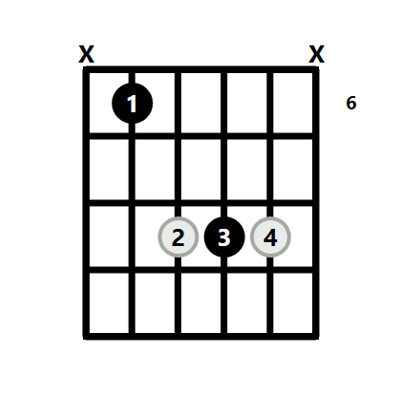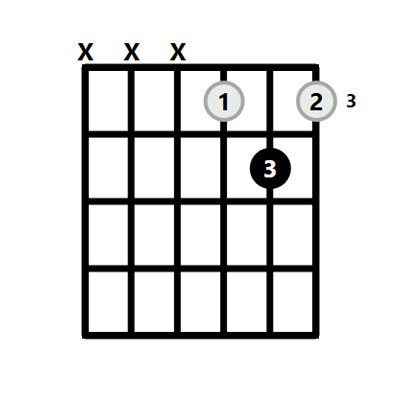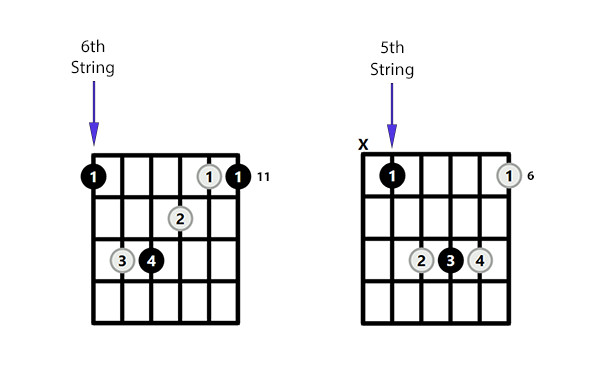The Eb Major chord is a foundational chord for guitarists across genres, from rock and pop to jazz and blues. Often one of the first barre chords that aspiring musicians tackle, the Eb chord’s versatility and rich sound make it an essential part of any guitarist’s toolkit.
In this comprehensive guide, we’ll dive deep into the Eb Major chord, exploring its theory, various shapes, and practical applications. Whether you’re a beginner just starting your chord journey or an experienced player looking to expand your knowledge, this article will equip you with everything you need to master the “E Flat Chord Guitar”.
Delving into E Flat Chord Theory
Before we jump into finger positions and diagrams, let’s briefly explore the music theory behind the Eb Major chord. Understanding the theory not only enhances your comprehension but also deepens your connection with the music you play.
- Chord Composition: The Eb Major chord is built from three fundamental notes: Eb, G, and Bb.
- Scale Origins: These notes are derived from the E Flat Major scale, specifically the 1st (root), 3rd, and 5th degrees.
- Interval Structure: Like all Major chords, the Eb Major chord follows a specific interval pattern from its root note: Major 3rd, minor 3rd, Perfect 4th (returning to the root note in the next octave).
- Key Harmony: The Eb Major chord holds a prominent position as the tonic (I) chord in the key of Eb Major. The complete set of chords within the key of E flat Major includes: Eb Major, F minor, G minor, Ab Major, Bb Major, C minor, and D diminished.
Understanding these theoretical aspects provides a solid foundation for learning and utilizing the Eb Major chord effectively.
10 Diverse Ways to Play the Eb Major Chord
For guitarists, visual aids are incredibly helpful. Below are 10 different shapes for playing the Eb Major chord across the fretboard. Experiment with these shapes to find your preferred voicings and expand your fretboard knowledge.
 Eb Major Chord – 10 Shapes
Eb Major Chord – 10 Shapes
Explore 10 different Eb Major chord shapes for guitar, showcasing varied finger positions across the fretboard for diverse sonic textures.
The Standard Eb Chord Shape: Rooted in Versatility
The most common and widely recognized Eb chord shape is rooted in the “root-5” barre chord family. Typically played starting at the 6th fret, this shape is a cornerstone for many guitarists. Interestingly, while classified as a barre chord, the index finger often doesn’t need to fully barre all six strings, primarily focusing on the root note on the 6th string.
This standard shape offers a full, resonant sound and is adaptable to various musical contexts.
 Eb Chord Guitar
Eb Chord Guitar
Diagram of the standard Eb Major chord on guitar, demonstrating the finger placement for the root-5 barre chord shape starting on the 6th fret.
The Easy Eb Chord Shape: A Beginner-Friendly Approach
For beginners or when a simpler voicing is desired, the “easy” Eb chord shape provides an excellent alternative. This simplified version focuses on the top three strings of the guitar, making it less physically demanding than barre chord shapes.
This easy Eb chord shape is essentially the same shape as the open D chord, but shifted up one fret. This familiar pattern makes it easier to grasp for those already acquainted with the open D chord.
 Easy Eb Chord Guitar
Easy Eb Chord Guitar
Illustration of the easy Eb Major chord shape for guitar, a simplified three-string version ideal for beginners and quick transitions.
Step-by-Step Guide to Playing the Standard Eb Major Chord
Sometimes, visual diagrams aren’t enough. Having step-by-step instructions can be incredibly helpful, especially when learning a new chord shape. Let’s break down the standard Eb Major chord shape:
- Index Finger Placement: Position your first finger on the 6th fret of the 5th string.
- Middle Finger Placement: Place your second finger on the 8th fret of the 4th string.
- Ring Finger Placement: Place your third finger on the 8th fret of the 3rd string.
- Pinky Finger Placement: Place your fourth finger on the 8th fret of the 2nd string.
- Strumming: Avoid strumming the 6th string and strum downwards across the top five strings (5th, 4th, 3rd, 2nd, and 1st).
Following these instructions methodically can confirm if you are correctly forming the standard Eb Major chord shape, ensuring accurate finger placement and sound.
Unleashing Barre Chord Power for Eb Major
Barre chords are indispensable for guitarists, providing movable shapes that unlock access to chords all across the fretboard. The Eb Major chord is readily playable as a barre chord using two primary barre shapes:
- Root 6 Barre Shape: Based on the E Major barre chord shape, positioned at the 11th fret.
- Root 5 Barre Shape: Based on the A Major barre chord shape, positioned at the 6th fret (this is the “standard” shape we discussed earlier).
Mastering these barre chord shapes for Eb Major expands your ability to play the chord in different positions and seamlessly transition between chords in various keys.
 Eb Barre Chord Guitar
Eb Barre Chord Guitar
Guitar chord diagram displaying Eb Major barre chord shapes, illustrating both root 6 and root 5 barre forms for fretboard versatility.
Eb Major Triads: Exploring Chord Inversions
Beyond full chord shapes, understanding triads – three-note chords – is crucial for developing a deeper harmonic understanding and creating interesting voicings. The Eb Major triad, comprised of Eb, G, and Bb, can be played in three inversions:
- Root Position: Eb – G – Bb (Root note as the lowest note)
- 1st Inversion: G – Bb – Eb (3rd of the chord as the lowest note)
- 2nd Inversion: Bb – Eb – G (5th of the chord as the lowest note)
Exploring these triad inversions allows for more melodic and nuanced chord playing, especially in lead guitar work or chord-melody arrangements.
 Eb Major Triad Guitar
Eb Major Triad Guitar
Visual representation of Eb Major triad guitar chords, showcasing root position, 1st inversion, and 2nd inversion shapes for harmonic variation.
Musical Keys Featuring the Eb Chord
Knowing which keys incorporate the Eb Major chord expands your musical vocabulary and helps you understand chord progressions and song structures. The Eb chord naturally appears in the following keys:
- Eb Major: (Eb, Fm, Gm, Ab, Bb, Cm, Ddim) – As the tonic chord.
- Bb Major: (Bb, Cm, Dm, Eb, F, Gm, Adim) – As the IV chord (subdominant).
- Ab Major: (Ab, Bbm, Cm, Db, Eb, Fm, Gdim) – As the V chord (dominant).
- C minor: (Cm, Ddim, Eb, Fm, Gm, Ab, Bb) – As the III chord.
- G minor: (Gm, Adim, Bb, Cm, Dm, Eb, F) – As the VI chord.
- F minor: (Fm, Gdim, Ab, Bbm, Cm, Db, Eb) – As the VII chord.
Understanding these key relationships enables you to anticipate Eb chord appearances in songs and create your own progressions using Eb effectively.
Alternative and Useful Eb Chord Shapes
While the standard shapes are essential, exploring alternative Eb Major chord shapes can add flavor and variety to your playing. These less common shapes can offer unique voicings and be useful in specific musical contexts. Experiment with these to broaden your sonic palette.
Chord Substitutions: Eb Major and Related Chords
The Eb Major chord can often be substituted with related chords to create harmonic interest and variations. Consider these substitutions:
- Eb sus 4: Adds a suspended, open quality.
- Eb sus 2: Creates a brighter, more melodic feel.
- Eb add 9: Introduces a jazzy, extended harmony.
Conversely, the Eb Major chord itself can often serve as a simpler substitute for more complex chords that share Eb as the root, such as Eb Major 7 or Eb7 chords (though it’s not a substitute for minor chords).
Scales to Solo Over the Eb Major Chord
For improvisation and melody creation over the Eb Major chord, certain scales are particularly effective. These scales complement the major tonality of the chord and provide melodic possibilities for soloing and songwriting:
- Eb Major Scale: The most fundamental and natural choice.
- Eb Pentatonic Major Scale: A simpler, bluesier option within the major tonality.
- Eb Mixolydian Mode: Adds a dominant 7th flavor, useful in blues and funk contexts.
Experiment with these scales to unlock your improvisational potential over the Eb Major chord.
Conclusion: Embrace the Versatility of the Eb Major Chord
The Eb Major chord is far more than just a barre chord to learn; it’s a gateway to musical expression and versatility on the guitar. From its theoretical foundations to its diverse shapes and applications, mastering the “e flat chord guitar” will significantly enhance your playing and musical understanding.
Continue to explore the different shapes, experiment with substitutions, and practice soloing over the Eb Major chord. The more you engage with this essential chord, the more its power and potential will unfold in your musical journey.
[

